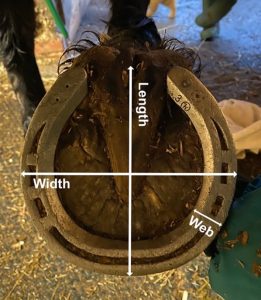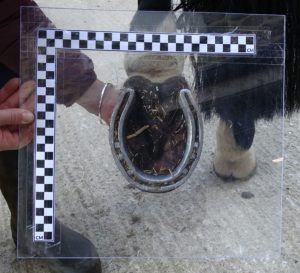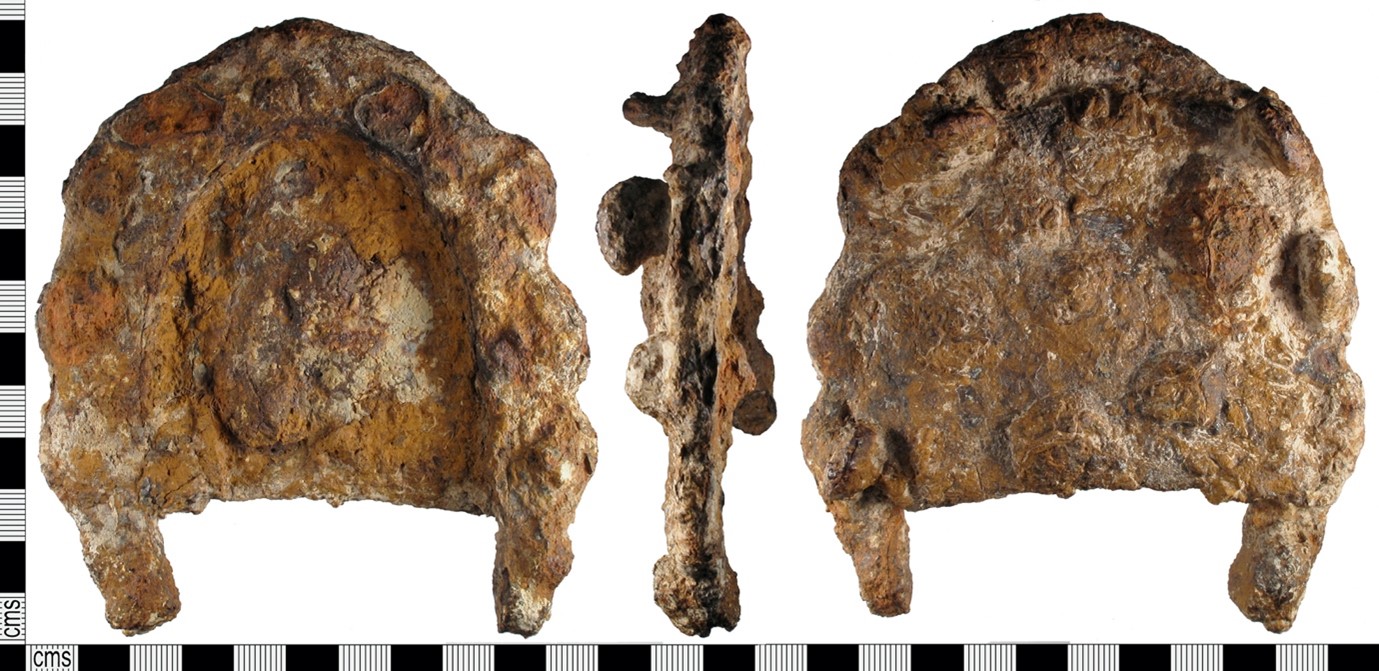I’m Tess Townend, a recent graduate of archaeology, and now a zooarchaeology master’s student at the University of Exeter. As a horse owner myself, the history and archaeology of horses is an area which I am particularly interested in. For my undergraduate dissertation I focused on medieval horseshoes, aiming to understand how much they can inform us about the size, stature and types of horses that wore them. This was accomplished through the metrical analysis of medieval horseshoes, in comparison to modern horses’ shoes, height and breed type.
In total, 103 medieval horseshoes dating from AD c. 900 – 1600 were sourced from the Portable Antiquities Scheme (PAS). The majority of measurements had already been taken by the PAS, these included the width, length and web (fig 1). The horseshoes had also been assigned to one of Clark’s (2004) four typologies, or in some instances as Guildhall or Dove type horseshoes.
| Type | Period of use | Identifying features |
| Type 1
(formally pre – Conquest) |
c. 900-1100 | ● Round and broad
● Wide web but thin metal ● Round Nail holes of usually 3 to a branch 7 – 8mm in diameter ● Large rectangular countersinking. ● T-shape nails ● Double clenching |
| Type 2
(formally Norman) |
· ‘Lobate’ wavy outer edge caused by deep countersunk slots
· 3 nails to each branch · Double clenching · Fiddle key nails · Calkins |
|
| c. 1050 – 1150 | Type 2a: Round nail holes | |
| c. 1150 – 1250 | Type 2b: Rectangular nail holes | |
| Type 3
(formerly transitional)
|
1250 – 1350 | · Generally heavier with broad web and smooth profiles
· Rectangular nail holes with narrow countersunk slots · Fiddle key nails or ‘eared’ nails 3-4 on each branch · Double clenching with some examples of spiralling |
| Type 4
(formally Later Medieval) |
c. 1350 – 1600 | · Broad web, sometimes tapering at the heel
· Square or rectangular nail holes with no counter sinking’s · Modern clenching |
| Dove: Angular inner profile | ||
| Guildhall: Heavier to Dove horseshoes, with broader webs with 4 nail holes on one or each branch |
A total of 80 modern horses were recorded (2 stallions, 32 mares and 46 geldings), which amounted to 28 different horse breeds in total. These breeds were then categorised into four different types of horse: light riding horse, pony, warmblood and draught. Overall, wither heights ranged from a 10hh Shetland pony to an 18.1hh Dutch warmblood. Recording live horses tends to be slightly tricky as they can sometimes be prone to fidgeting. A different way of measuring was therefore utilised (fig 2), and the same measurements as the medieval horseshoes were taken.

Fig 1. Measurements recorded (photo: T. Townend)

Fig 2. Recording board (photo: T. Townend)
So how do medieval horseshoe metrics compare to modern horseshoes? Preliminary analysis shows the majority of medieval horseshoes were the same size as those of the modern-day ponies. Therefore, these horseshoes were likely worn by horses that were 14.2hh and under, but their overall size increased throughout the medieval period, particularly from 1300 onwards. These results nicely align with the current zooarchaeological narrative.
Although it is difficult to identify the exact function of horses from their horseshoes, there are some horseshoes that do give some possible indication. For example, orthopaedic shoes may indicate the presence of elite horses. Figure 3 shows a Type 2 horseshoe with an attached metal plate that was possibly utilised to avoid lameness from stones or hard ground, similar to the padding used in modern farriery work. These finds are rare, but obviously show a degree of care for the horse. These horseshoes were perhaps used on elite riding horses, or warhorses, where a large investment for a good horse had been made.

Fig 3. PAS Find ID: SUSS-973667, Type 2 Horseshoe with calkins and orthopaedic plate dated to the 11th – 13th century AD (courtesy of the Portable Antiquities Scheme).
The shape of the horseshoe may also indicate what type of horse wore them, and to some extent the horse’s function. Heavier draught horses often have much ‘broader’ hooves, which are advantageous to agricultural work, whilst ponies and light riding horses generally have ‘long and narrow’ hooves. The presence of some ‘broad’ and or larger horseshoes, in addition to evidence for an increase in metatarsal robusticity, may reflect the development of stockier builds, such as draught horses, from 1300 AD onwards.
Overall, it is clear that medieval horses were generally the size of modern-day ponies, and that a variety of horse types were utilised for different functions. Though this is only a brief analysis, it clearly demonstrates that a good deal of information about medieval horses can be ascertained from an analysis of their horseshoes.
References
Clark, J. (2004): The medieval horse and its equipment, c. 1150-c. 1450. Boydell Press.
Ameen, C. Benkert, H. Fraser, T. Gordon, R. Holmes, M. Johnson, W. Lauritsen, M. Maltby, M. Rapp, K. Townend, T. Baker, G. P. Jones, L.M. Camille Vo Van Qui, Webley, R. Liddiard, R. Sykes, N. Creighton, O. H. Thomas, R. and Outram, A. K. (2021): In search of the ‘great horse’: A zooarchaeological assessment of horses from England (AD 300–1650). International Journal of Osteoarchaeology, 31(6): 1247-1257.
I am wondering if you might know anything about the purpose of the strange-looking, studlike addition to the horseshoes on two drawings of horses in the second half of the thirteenth century: Sweyn Forkbeard’s horse in The Life of King Edward the Confessor (Cambridge, University Library, MS Ee.3.59) c.1255 and the horse in the bottom right of the Hereford Mappa Mundi.
Is this a military technology? It looks like it might be uncomfortable for the horse.
Links:
Sweyn Forkbeard horses https://cudl.lib.cam.ac.uk/view/MS-EE-00003-00059/13
Hereford horse https://upload.wikimedia.org/wikipedia/commons/4/48/Hereford-Karte.jpg
Thanks for the question. The stud-like projections seem to be representations of horseshoe nails that were designed to project from the shoe to help grip. They can be seen on wall paintings and even floor tiles, including this famous one in the British Museum: https://www.bmimages.com/preview.asp?image=00578948001